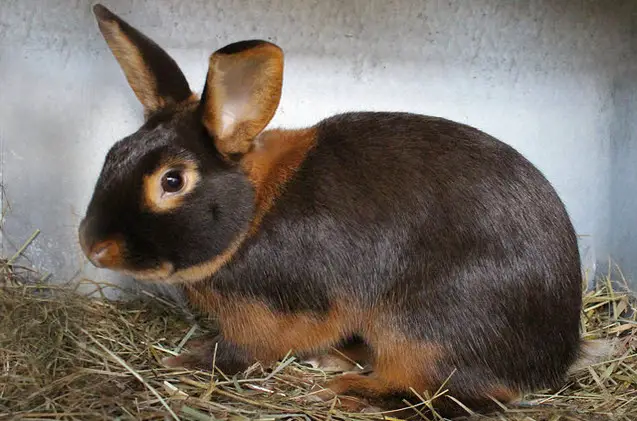Basic Appearance:
Tans are a graceful and lively breed. They are small and trim, looking more like hares than rabbits. They have beautiful tan markings which resemble those of Doberman Pincher dogs.
History, Temperament, and Common Uses:
Tans originated in England. They were discovered in the 1880’s, in a colony of wild rabbits that had bred with domestic rabbits, and breeders set about raising and refining these tan marked rabbits. Tans continued to grow in popularity in England, with blacks, blues, chocolates, lilacs all appearing by the 1920’s. The tans were more cobby than the ones we have today and resembled Dutch in body type. In America the first specialty club was formed in 1936, but petered out and was later replaced by the American Tan Rabbit Specialty Club in 1960. In America, it wasn’t until the 1990’s that breeders began favoring a full arch typed breed, and the standard was given some major revisions. A tan won Best in Show at the ARBA Convention in 2003, and the breed continues to gain popularity.
Tans are energetic and lively rabbits. They can be a little high strung, but are not at all mean. They are friendly, and are “people rabbits.” They are very intelligent as well.
Tans are gaining popularity as show rabbits. Their type has improved greatly and tans are quite competitive in local and national shows.
Tans also excel in the new sports of rabbit hopping and agility. Their energy, intelligence, and athletic build make them the perfect choice for these growing sports.
If you want a lively and unique pet rabbit, tans are a good choice. They are friendly and lively, but are not likely to be cuddly rabbits.
Grooming, Care, and Additional Notes:
Tans require almost no grooming. Simply brushing their coat with a soft brush to remove loose hairs will keep their shining coat looking its best. Like other breeds, tans will need more frequent grooming during a molt.
Tans are naturally lively and enjoy running table when being judged. If your rabbit is shy, giving him exercise time at home will help him gain confidence.
Tans are usually judged starting with the lightest variety, lilac. This is followed by blue, chocolate, and black, respectively. This is because the tan will not be as rich on the lighter varieties. If the judge started with the blacks, the tan markings on the other varieties would look too pale in comparison. Even so, blacks are the most competitive variety.
Tan At A Glance…
Recognized Varieties:
Black, blue, chocolate, and lilac.
ARBA Body Type:
Full Arch
Approximate Size:
4 to 6 pounds.
Important Things to Look for When Buying Show Stock:
Tans are a full-arched breed. Their body should be short, deep, rounded, and carried up off the table, with plenty of daylight showing under the belly. The topline should start at the base of the neck and continue over the midsection, then curving gracefully down from the midsection to the lower hindquarters. When viewed from above there should be a slight taper from the widest point at the hindquarters to the shoulders. The body should be trim and graceful.
The legs should be long, with forelegs fully extended to reveal the correct type. Hind legs should be long enough to keep the hindquarters off the table, and set the same width as the hindquarters. Tans should have medium-fine bone.
Look for rabbits that give the appear graceful, alert, sleek, and elegant. They should move about the table with ease.
Fur should be medium-fine, with a snappy flyback when stroked backwards. Look for a short, even coat with a high shine.
All four colors should be even and as rich as possible.
Look for tan color that is intense and uniform. It should be a rich mahogony with a bright red tint. The tan should cover the entire underside of the rabbit, starting at the chin, going down the chest, belly, and underside of tail. Tan markings should be present at the triangle, collar, nostrils, eye circles, pea spots, and ear lacing. There should be a brindling of tan-tipped guard hairs along the flanks and rump.
Things to Avoid:
Rabbits giving the impression of being wide or blocky. Flatness of body type, lack of arch, hindquarters that are broad or flat. Too long or rangy in body type, too short or cobby in body type. Short legs or heavy bone, bulky body, long ears, or snipey head. A dewlap is a disqualification.
Wiry, thin, or long coat. Fur with a dead appearance or lacking gloss. Ears not well furred. Stray white hairs, brownish ting, or stray tan hairs. White spots, white toenails, or eyes not matching the standard for the variety will be disqualified.
Body color mixing with tan color. Indistinct demarcation between tan and body color. Brindling absent.

